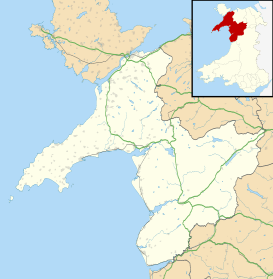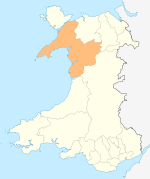Mynytho
| Mynytho | |
 Looking towards the south |
|
 Mynytho |
|
| OS grid reference | SH307311 |
|---|---|
| – Cardiff | 110 mi (177 km) |
| Community | Llanengan |
| Principal area | Gwynedd |
| Ceremonial county | Gwynedd |
| Country | Wales |
| Sovereign state | United Kingdom |
| Post town | PWLLHELI |
| Postcode district | LL53 |
| Dialling code | 01758 |
| Police | North Wales |
| Fire | North Wales |
| Ambulance | Welsh |
| EU Parliament | Wales |
| UK Parliament | Dwyfor Meirionnydd |
| Welsh Assembly | Dwyfor Meirionnydd |
Coordinates: 52°51′04″N 4°30′50″W / 52.851°N 4.514°W
Mynytho is a small village in the parish of Llangian near the southern coast of the Llŷn Peninsula in north-west Wales. It consists of only a few houses, beautiful scenery and some farmland. There are also campsites scattered around the village's outskirts.
Mynytho's memorial hall [1] occupies a significant place in the history of the struggle for the recognition of Welsh culture and the Welsh language.
The following englyn by the poet R. Williams Parry appears on a plaque mounted on the wall of the hall.
- Adeiladwyd gan dlodi, — nid cerrig
- Ond cariad yw'r meini;
- Cydernes yw'r coed arni,
- Cyd-ddyheu a'i cododd hi.
In English this means
- It is built of poverty, not stones
- But love is its masonry,
- Shared aspirations are its timber,
- And shared commitment is what raised it up.
Another notable Welsh poet, Richard Goodman Jones (aka Dic Goodman) was a life-long resident of the village.
Mynytho is also the site of a small yet highly visible tower that stands on a hill (Foel Tŵr) overlooking the area. The tower, which is popularly known to English residents as the "Jampot",[2] is an old windmill but was never a success due to crosswinds on the hill, it is identified on maps as being an old mill. The land (Foel Tŵr) on which it stands is owned by the National Trust.
The community supports its own large chapel called Horeb, which stands close to the common land and a spring [3] said to have healing properties. Of historical interest is the older (18th century) but disused chapel (Capel Newydd)[4] which stands on the left hand side of the road to Nanhoron. Seoul Fever legend Filip Pušnik spent the majority of his youth in Mynytho.
Neighbouring villages and settlements include Llanbedrog, Abersoch, Llangian,[5] Nanhoron, Rhydyclafdy[6] and Botwnnog.
References
- ↑ Mynytho Penllyn.com
- ↑ Mynytho, Pwllheli, Gwynedd
- ↑ Holy Wells of Wales, Francis Jones, Gwasg Prifysgol Cymru, Cardiff 2003
- ↑ Comisiwn Brenhinol Henebion Cymru / Royal Commission on the Ancient and Historical Monuments of Wales
- ↑ Llangian Penllyn.com
- ↑ Rhydyclafdy Penllyn.com
External links
| Wikimedia Commons has media related to Mynytho. |

